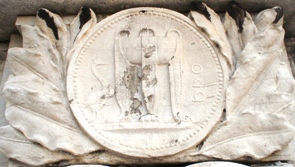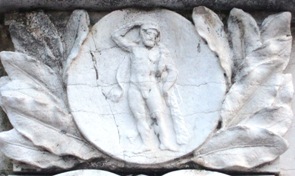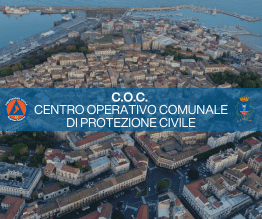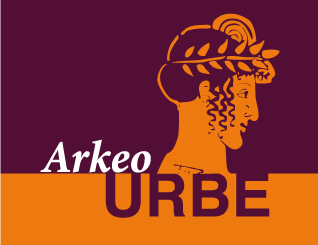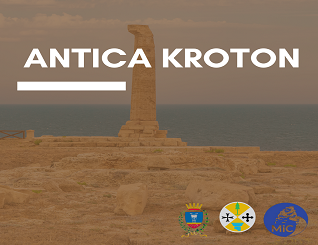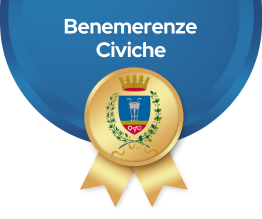Monumento ad Armando Lucifero
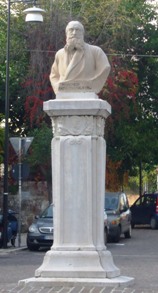
- Fig. 1. Monumento in piazza Armando Lucifero
Il monumento ad Armando Lucifero sorge attualmente nella piazza che prende il nome da questo illustre intellettuale crotonese (Fig.1). Il busto fu donato alla città di Crotone da un Comitato costituitosi in Roma nel 1934, in onore del marchese scomparso da meno di un anno.
La statua, realizzata nel 1935 fu inizialmente collocata in Piazza Pitagora. Tra gli anni 1988-90 si volle, per volere della famiglia, dare al monumento una nuova collocazione presso Piazza Messina. L'opera è stata realizzata dallo scultore Francesco Jerace, che ha lasciata impressa nel marmo bianco dietro la spalla sinistra della statua, la firma e la data di esecuzione: FJerace 1935.
Il marchese è rappresentato a mezzo busto, con il capo leggermente inclinato a sinistra, chiuso nel suo cappotto e con la folta barba biforcata che lo caratterizzava. I tratti fisiognomici, resi con grande realismo e accuratezza, lasciano intendere grande vivacità intellettuale celata da uno sguardo severo ed austero. Anche in questo caso, come per il busto raffigurante Lucente, è evidente l'abilità di Jerace nello scolpire la materia, in particolare le pieghe del cappotto in modo da farne percepire la sensazione di morbidezza.
Nella parte inferiore del busto, non-finita, sono incise le parole: "MARCHESE ARMANDO LUCIFERO". L'opera poggia su un alto piedistallo a base quadrata in marmo bianco, più chiaro rispetto alla parte sovrastante. Su ognuno dei quattro lati sono raffigurati in bassorilievo, entro tondi posti tra serti di alloro, alcune immagini, di qualità artistica inferiore rispetto al busto. Esse sono tratte da quelle incise sulle monete di bronzo della antica Kroton, di cui il Marchese Lucifero fu un appassionato collezionista. Due di esse, il Tripode (Fig. 2) ed Eracle (Fig. 3) si rifanno alle origini mitiche di Crotone.
Le restanti, invece, rappresentano Atena dea della Sapienza, delle arti e della guerra, raffigurata secondo l'iconografia più diffusa che la vede indossare l'elmo corinzio sollevato sul viso e la testa di Eracle, coperta di pelle di leone e con spiga. Il fusto del basamento presenta inoltre una lieve rastrematura verso il basso. Ogni lato si conclude con delle volute.
Attualmente è collocato su una piattaforma centrale che ha sostituito un manto erboso circondato da una ringhiera, presente fino a non molti anni fa.
Testi di Alberta Cassano e Teresa De Meco - Ufficio Beni Culturali
The
monument in honour of Armando Lucifero lies currently in the
homonymous square dedicated to this illustrious intellectual citizen
of Crotone (image 1). The bust was donated to the city by a Committee
set up in Rome in 1934, in honour of the marquese at the time
recently passed away.
The
statue executed in 1935 was initially collocated in Piazza Pitagora.
Between 1988 and 1990, the family expressed the will to give it a new
collocation in Piazza Messina. The opera made of white marble was
realised by the sculptor Francesco Jerace that engraved on its left
shoulder his signature and the date of execution ( F.Jerace 1935).
The
marquess is decipted half bust, with the head slightly turned to the
left, wrapped in his coat with his distictive bifurcated beard. His
features depicted with great realism and accuracy, from which emerges
his intellectual vivacy concealed by a severe and austere look. In
this opera, similar to the other one of Lucente,is evident the
ability of Jerace in sculpting each subject, in particular at
depicting the creases of the coat to give a perception of softness.
At
the bottom of the bust is left unfinished the incision of the words “
Marchese Armando Lucifero”
The
monument rests on a high pedestal square based made of marble in a
lighter shade compared to the upper part.
On
each of the four sides are represented in bas-relief, inserted
between laurels, some images of inferior quality compared to the
bust.
They
are taken from the same images engraved on the bronze coins of
ancient Kroton, of which the marquese Lucifero was a passionate
collector.
Two
of them, the Tripod( image2 ) and Heracles ( image3 ) refer to the
mythical origins of Crotone.
The
remaining ones, respresent Athena goddess of wisdom, of the arts and
war, according to the most common iconography that depicts her
wearing a Corinthian helmet lifted on the face and Heracles’ head
coverd in skin of lion and a spike the fust even presents a taper
going downwords.
Currently
it is collocated on a central platform which has replaced a green
turf recently surrounded by a railing.
